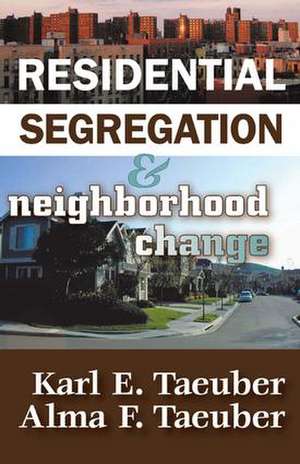Residential Segregation and Neighborhood Change
Editat de Karl E. Taeuberen Limba Engleză Hardback – 22 noi 2017
Residential segregation historically occupies a key position in patterns of race relations in the urban United States. It not only inhibits the development of informal, neighborly relations between white people and African Americans, but ensures the segregation of a variety of public and private facilities. The clientele of schools, hospitals, libraries, parks, and stores is determined in large part by the racial composition of the neighborhood in which they are located. Problems created by residential segregation are the focus of this of this work.
African Americans in cities resemble whites in cities. Both racial groups are highly urbanized, and most of the immigrants of either race to a city are former residents of another city. Within cities, racial groups display similar patterns of residential behavior, with those of higher incomes seeking out newer and better housing. Both races respond similarly to national, social, and economic factors which set the context within which local changes occur. Karl E. and Alma F. Taeuber's main approach to the analysis of residential segregation and processes of neighborhood change is comparative and statistical. By quantitative comparison of the situation in many different cities, they attempt to assess those patterns and processes which are common to all communities and those which vary.
Residential segregation is shown to be a prominent and enduring feature of American urban society. By bringing empirical data to bear on an important and timely social problem, this book will aid in the search for reasonable solutions. All types of cities, southern and northern, large and small, are beset with the difficulties that residential segregation imposes on harmonious race relations and on the solution of pressing city problems. Residential segregation is a real problem that must be faced directly, as it is in this important work.
| Toate formatele și edițiile | Preț | Express |
|---|---|---|
| Paperback (1) | 417.20 lei 6-8 săpt. | |
| Taylor & Francis – 15 mar 2009 | 417.20 lei 6-8 săpt. | |
| Hardback (1) | 1000.27 lei 6-8 săpt. | |
| Taylor & Francis – 22 noi 2017 | 1000.27 lei 6-8 săpt. |
Preț: 1000.27 lei
Preț vechi: 1219.84 lei
-18% Nou
Puncte Express: 1500
Preț estimativ în valută:
191.42€ • 207.86$ • 160.80£
191.42€ • 207.86$ • 160.80£
Carte tipărită la comandă
Livrare economică 22 aprilie-06 mai
Preluare comenzi: 021 569.72.76
Specificații
ISBN-13: 9781138531956
ISBN-10: 1138531952
Pagini: 304
Dimensiuni: 152 x 229 x 19 mm
Greutate: 0.45 kg
Ediția:1
Editura: Taylor & Francis
Colecția Routledge
Locul publicării:Oxford, United Kingdom
ISBN-10: 1138531952
Pagini: 304
Dimensiuni: 152 x 229 x 19 mm
Greutate: 0.45 kg
Ediția:1
Editura: Taylor & Francis
Colecția Routledge
Locul publicării:Oxford, United Kingdom
Cuprins
LIST OF FIGURES, LIST OF TABLES, 1. PREVIEW OF PRINCIPAL FINDINGS, PART ONE: THE PATTERN OF NEGRO RESIDENTIAL SEGREGATION, 2. THE DEVELOPMENT OF AN URBAN NEGRO POPULATION, 3. NEGRO RESIDENTIAL SEGREGATION IN UNITED STATES CITIES, 4. SOCIAL AND ECONOMIC FACTORS IN RESIDENTIAL SEGREGATION, PART TWO: THE PROCESS OF NEIGHBORHOOD CHANGE, 5. THE PREVALENCE OF RESIDENTIAL SUCCESSION, 6. THE CHANGING CHARACTER OF NEGRO MIGRATION, 7. CONCOMITANTS OF RESIDENTIAL SUCCESSION, 8. RACE AND RESIDENTIAL DIFFERENTIATION, APPENDIX A. THE MEASUREMENT OF RESIDENTIAL SEGREGATION, APPENDIX B. SUPPLEMENTARY TABLES ON RESIDENTIAL SUCCESSION, APPENDIX C. SUPPLEMENTARY TABLES ON CLASS SEGREGATION, APPENDIX D. MAPS OF CENSUS TRACTS IN TEN CITIES, CLASSIFIED BY TYPE OF RACIAL CHANGE, SELECTED BIBLIOGRAPHY, INDEX
Descriere
This book is an invaluable reference. First published in 1965, it is at once a snapshot of a moment in history and a timeless conceptualization of the issues inherent in societal segregation.
Residential segregation historically occupies a key position in patterns of race relations in the urban United States
Residential segregation historically occupies a key position in patterns of race relations in the urban United States













